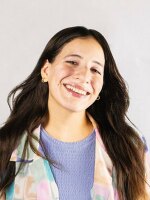"Before, Spanish was never spoken," Aurelia Ojeda explained, translating her mother Virginia Melendrez’s words from Kumeyaay to Spanish.
"For example, she and my grandmother, with my 'nana,' it was all Kumeyaay. She says you would get up to cook, make tortillas, cut firewood, and everything was spoken in Kumeyaay, nothing in Spanish," she said.
Ojeda and Melendrez are members of the Kumeyaay community in San José de la Zorra, Baja California, which is located roughly an hour north of Ensenada and seven miles from Ejido El Porvenir. The journey from the Tijuana border to this location takes approximately three hours.
San José de la Zorra is a valley surrounded by several hills with abundant vegetation. According to the Ojeda family, the community has a couple of schools where children receive their education, with all classes conducted in Spanish.
Ojeda, together with her son Ángel Díaz Ojeda, discussed how the Kumeyaay language has been gradually lost through generations. Ojeda, who first learned to speak Kumeyaay as a child, shared that currently not all children are interested in learning the language and that preserving it largely depends on the education they receive at home.
The Kumeyaay language is facing a critical threat of extinction, as reported by the Atlas of Indigenous Peoples of Mexico. The 2020 census revealed that there are only 381 remaining speakers.
On the other side of the border
The Kumeyaay population extends on both sides of the U.S.-Mexico border, reaching San Diego and Imperial counties. It is estimated that approximately 3,500 Kumeyaay reside in this region; however, there is limited information regarding the number of individuals who speak the Kumeyaay language.
The Ojedas stay in touch with Kumeyaay families across the border, despite the language barrier since families there don't speak Spanish. However, they manage to interact and engage in conversations using the little English and Kumeyaay they know.
"You have to ask, because besides that, there are also a few Kumeyaay variants right here in Baja," Díaz Ojeda said.
Discrimination and shame
Ángel said Spanish is the main language in San José de la Zorra and believes discrimination is more prevalent within the community than from outside.
"You have to break those strong barriers and not be ashamed of the little you know," he said. "The little you know, you have to speak it because the child will look at you and follow the example."
He referred to adults in the community who avoid speaking the language. He believes they should set an example for children to normalize it and prevent shame in speaking Kumeyaay.
Although his first language was Spanish, he frequently heard Kumeyaay at home and understands it well, but he needs to practice it more, he said.
Holding onto what's left
Díaz Ojeda emphasized the importance of holding onto the remnants of their language.
"There's no other way, maybe the language is going to change a little. Cling to the little that remains, and continue it so that it doesn't die," Díaz Ojeda reflected on how previous generations, including his mother and grandmother, spoke words that no longer exist today.
Margaret Field, who has a doctorate in Linguistics and is a professor of American Indian Studies at San Diego State University, said that there are ongoing efforts on both sides of the border to preserve the language.
She mentioned that in Mexico Yolanda Meza, from the Nejí community in Tecate, has been teaching Kumeyaay online for years. And the Mexican government office National Institute of Indigenous Languages (INALI) has published at least one book in Kumeyaay.
Díaz Ojeda suggested that embracing technology could play a crucial role in language preservation, noting that children spend much of their time on their phones. He suggested creating a Kumeyaay language app to help younger people learn.
Meanwhile, Ojeda envisions building a school, which she refers to as "a little willow house," to teach Kumeyaay to the community's children.
"The little that is fought for, the little that is rescued, the little that we have done or will do, will be quite a lot," Ojeda said.









